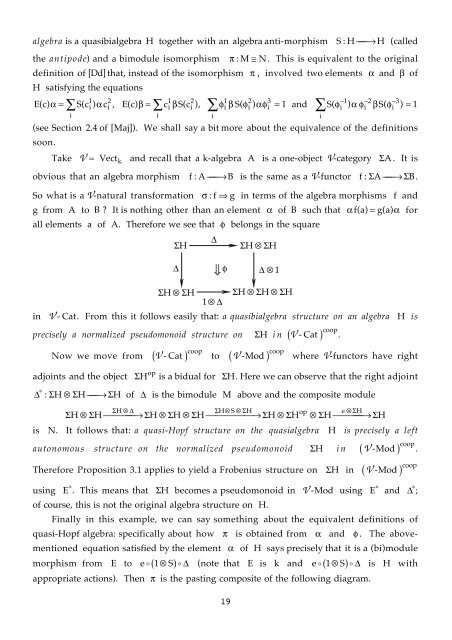Frobenius monads and pseudomonoids Introduction - ResearchGate
Frobenius monads and pseudomonoids Introduction - ResearchGate
Frobenius monads and pseudomonoids Introduction - ResearchGate
Create successful ePaper yourself
Turn your PDF publications into a flip-book with our unique Google optimized e-Paper software.
algebra is a quasibialgebra H together with an algebra anti-morphism S: H æÆ æ H (called<br />
the antipode) <strong>and</strong> a bimodule isomorphism p :M@ N.<br />
This is equivalent to the original<br />
definition of [Dd] that, instead of the isomorphism p , involved two elements a<br />
H satisfying the equations<br />
<strong>and</strong> b of<br />
Ec () a = ÂSc ( i) aci<br />
1 2 , Ec () b = Âci bSc<br />
( i )<br />
1 2 1 2 3<br />
, Â fi bS( fi ) afi<br />
= 1<br />
-1 -2 -3<br />
<strong>and</strong> Â S( fi ) a fi bS( fi<br />
) = 1<br />
i<br />
i<br />
i<br />
(see Section 2.4 of [Maj]). We shall say a bit more about the equivalence of the definitions<br />
soon.<br />
Take V = Vect k <strong>and</strong> recall that a k-algebra A is a one-object V-category SA. It is<br />
obvious that an algebra morphism f: A æÆ æ B is the same as a V-functor f: SA æÆ æ SB.<br />
So what is a V-natural transformation s :ffi g in terms of the algebra morphisms f <strong>and</strong><br />
g from A to B ? It is nothing other than an element a of B such that afa ( ) = ga ( ) a for<br />
all elements a of A. Therefore we see that f belongs in the square<br />
in<br />
SH<br />
D<br />
SH ƒ SH<br />
fl f<br />
D Dƒ1 SH ƒ SH<br />
SH ƒ SH ƒ SH<br />
1 ƒD<br />
V - Cat. From this it follows easily that: a quasibialgebra structure on an algebra H is<br />
precisely a normalized pseudomonoid structure on SH in<br />
V - Cat coop<br />
( ) .<br />
Now we move from V - Cat coop<br />
( ) to V -Mod coop<br />
( ) where V-functors have right<br />
adjoints <strong>and</strong> the object SH op is a bidual for SH. Here we can observe that the right adjoint<br />
*<br />
D : SH ƒ SH æ æÆ<br />
SH<br />
of D is the bimodule M above <strong>and</strong> the composite module<br />
SH ƒ D SHƒS ƒ SH op e ƒ SH<br />
SH ƒ SH æææÆ SH ƒ SH ƒ SH æææææÆ SH ƒ SH ƒ SH ææ æÆ<br />
SH<br />
is N. It follows that: a quasi-Hopf structure on the quasialgebra H is precisely a left<br />
autonomous structure on the normalized pseudomonoid SH in<br />
Therefore Proposition 3.1 applies to yield a <strong>Frobenius</strong> structure on SH in<br />
i<br />
coop<br />
( V -Mod ) .<br />
coop<br />
( V -Mod )<br />
using E * . This means that SH becomes a pseudomonoid in V -Mod using E * <strong>and</strong> D * of course, this is not the original algebra structure on H.<br />
;<br />
Finally in this example, we can say something about the equivalent definitions of<br />
quasi-Hopf algebra: specifically about how p is obtained from a <strong>and</strong> f . The abovementioned<br />
equation satisfied by the element a of H says precisely that it is a (bi)module<br />
morphism from E to eo ( 1 ƒ S)<br />
o D (note that E is k <strong>and</strong> eo ( 1 ƒ S)<br />
o D is H with<br />
appropriate actions). Then p is the pasting composite of the following diagram.<br />
19
















